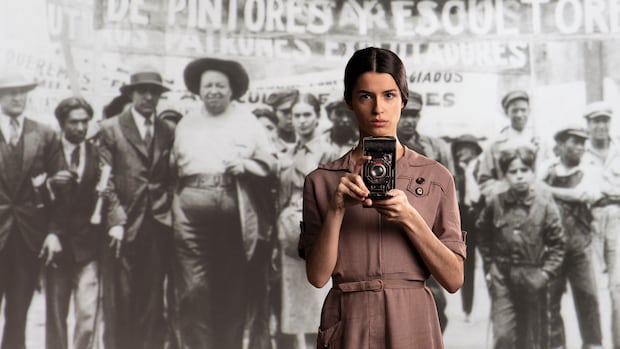ArtsFire Never Dies, a new play on now in Vancouver, explores the life of the 20th century photographer-turned-activistFire Never Dies explores the life of the 20th century photographer-turned-activistElena Massing · CBC News · Posted: Oct 15, 2025 9:00 AM EDT | Last Updated: 10 hours agoMarianna Zouzoulas as Tina Modotti in Fire Never Dies: The Tina Modotti Project. (David Cooper)Tina Modotti isn’t a household name, but she lived and worked with people who were. The Italian photographer had an affair with Edward Weston, one of the 20th century’s most influential photographers. And when the two moved to Mexico City together, she moved in the same circles as Frida Kahlo and Diego Rivera.Her artistry has been overshadowed by these relationships, but in Fire Never Dies: The Tina Modotti Project — premiering this month at the Historic Theatre of Vancouver’s arts and culture hub the Cultch — her story is finally at the forefront. The play spans 25 events in Modotti’s life, following her through 1920s Mexico City, during the peak of her artistic career, and when she left photography behind to be an activist.Modotti’s relationship with Weston was complex. He wasn’t just her lover — he was also her mentor. He taught her about composition and formalism, which prioritizes lines and shapes over the subject of a photo. Weston believed the subject matter didn’t have to be substantial and that the esthetic value was enough.Modotti, however, explored the political with her photos of the working-class experience. One of her most famous, Worker’s Hands, is a close-up of a pair of hands resting on the handle of a tool. It’s a simple yet moving depiction of a life of labour.”What’s compelling to me about her is not just that she took extraordinary photos in terms of form and content,” says Carmen Aguirre, the play’s writer and director. “A lot of the content of the photos that I was drawn to are photos of the poor. And they are photos that are not exploitative or extractive or engage in any kind of appropriation, because that is where she came from. She came from abject poverty.”During the Spanish Civil War, Modotti joined the anti-fascist cause and travelled to Spain to volunteer as a nurse for the left-leaning government. Aguirre was intrigued by the choices and circumstances that inspired Modotti to leave art behind, and the play was a way to interrogate the relationship between art and social justice.”For me, her story was the perfect way to explore larger questions of What is the purpose of art in the face of fascism and … can it serve the poor? And if so, how?” she says.Aguirre first read a book about Modotti 35 years ago. At the time, Aguirre was in theatre school and struggling with the fact that her courses were only focused on refining skills. Born in Chile, where “art is married to politics,” as she says, it felt as if something was missing. And learning about Modotti, Aguirre felt less alone in how she approached her work.Melissa Oei, Marianna Zouzoulas, and Praneet Akilla in Fire Never Dies: The Tina Modotti Project (David Cooper)Around 15 years ago, she came back to Modotti’s story and tried writing a one-woman show. She worked on three heavily researched drafts and abandoned them all. “They didn’t work because there was no present tense,” she says. “In order for a play to work, we need to be watching the characters on stage solving some kind of a problem. And I couldn’t crack that, so I put it away.”During the pandemic, Aguirre revisited her old drafts and scrapped them yet again. But this time, she started over with more characters, and everything fell into place.One of those characters is Modotti’s heart, played by an actor. Modotti had died of a heart attack at 45 while alone in the back of a cab, and the entire play takes place in those last 10 seconds of her life as she works out her unresolved issues.Modotti also left hundreds of photos behind, and some of the people pictured become characters onstage too — Aguirre’s way of bringing them to life.Modotti herself is played by Marianna Zouzoulas, who says having those photos and the backstory to work with was invaluable.However, Aguirre struggled to fit all of that content into one play, especially with so many high-profile characters, who could be the focus of their own play. Her solution was to give each character a minute of introduction, in which they walk down a runway to a song that represents them.Fire Never Dies seamlessly blends different genres, while jumping between points in Modotti’s life. But Zouzoulas says those tone and time shifts were among the biggest challenges of the role. The play goes from the catwalk to a film-noir esthetic — during her time in Berlin when she was fleeing Mexico’s anti-communist campaign — to naturalism for parties in Mexico.Both Aguirre and Zouzoulas say Modotti’s story— especially how she was criticized for her activism — is still relevant today. “Nothing has changed, almost 100 years later, in terms of how we talk about the resistance, how we view these people as terrorists and how we villainize the way they express their art,” Zouzoulas says. “It’s always timely, in my view, to hear from a working-class revolutionary woman,” Aguirre says. “A lot of the characters … that we see on Canadian stages are middle class and up. I’m just thrilled that we have this working-class woman on stage, and she’s taking up all the space.”Fire Never Dies: The Tina Modotti Project runs until Oct. 26 at The Cultch Historic Theatre (1895 Venables St.) in Vancouver.ABOUT THE AUTHORElena Massing is a freelance journalist based in Vancouver. She’s an opera and informatics student at UBC, and has been the culture editor at The Ubyssey since 2023.
This play wants to make artist and activist Tina Modotti a household name












